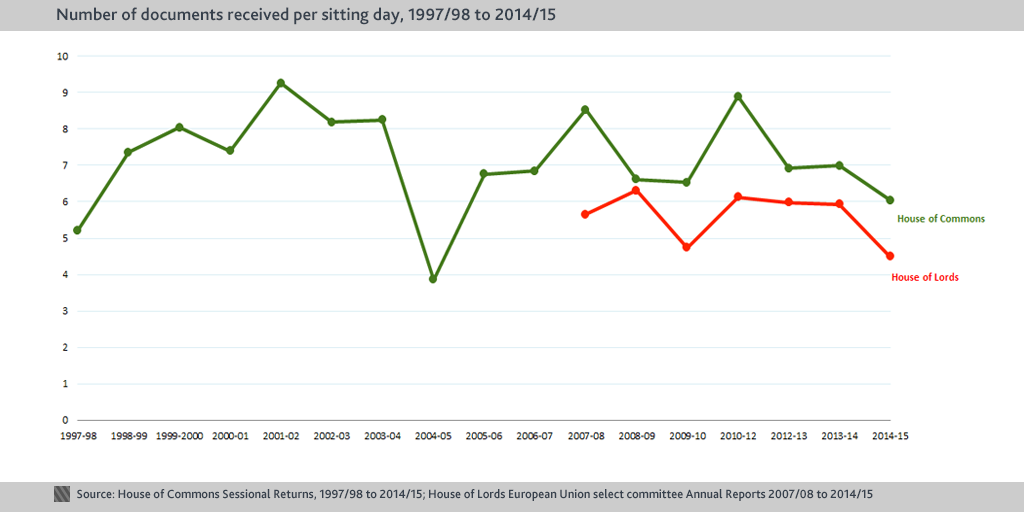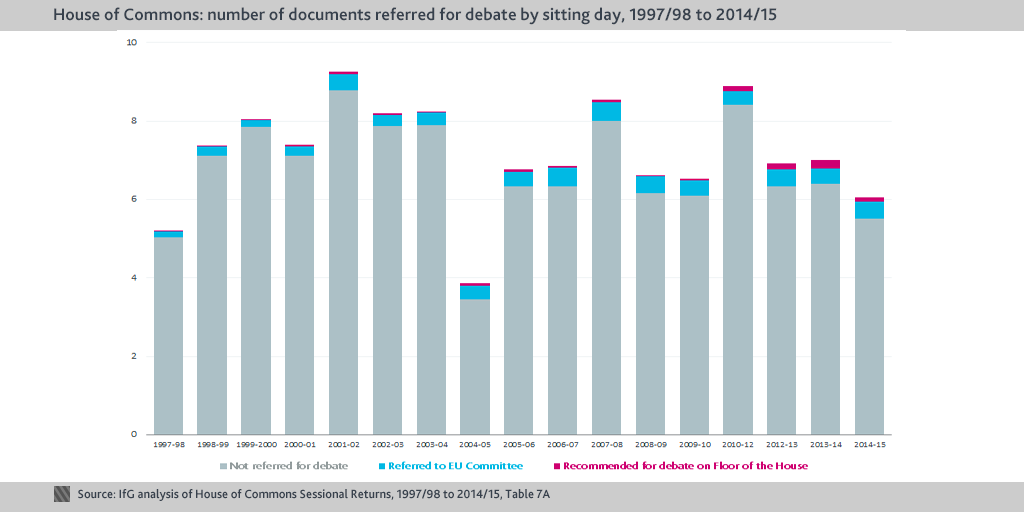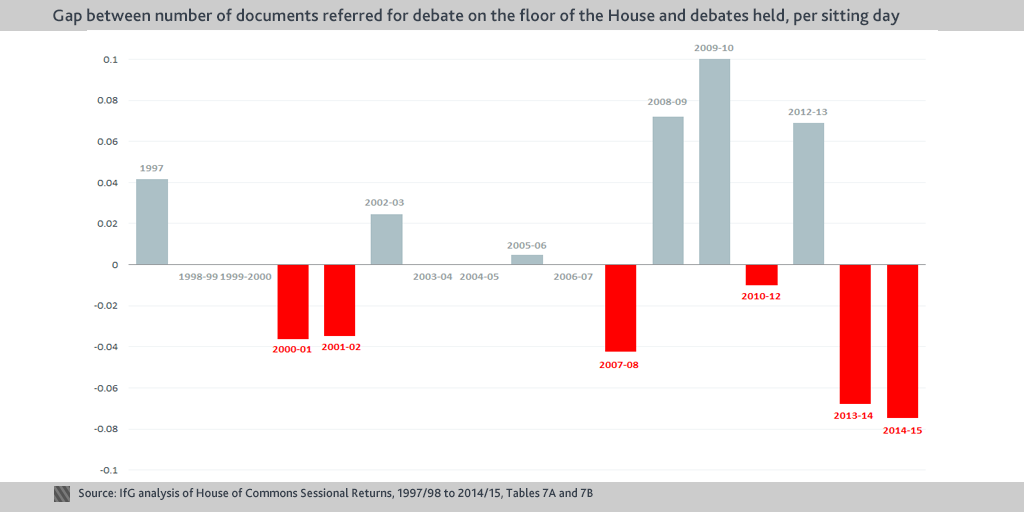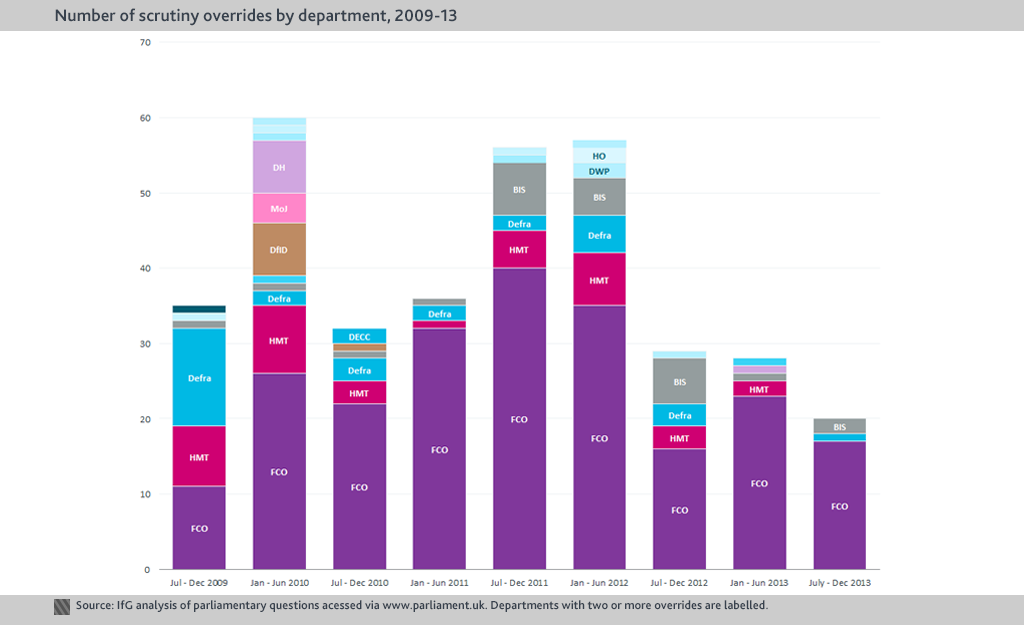As part of his bid to renegotiate the UK’s membership with the European Union, the Prime Minister wants to strengthen the power of national parliaments over EU decision making. But little has been said about how successfully the UK Parliament fulfils the domestic side of its EU scrutiny role in holding ministers to account. Robyn Munro and Hannah White outline the role of Parliament in holding the UK Government to account for EU policy.
The main focus of most national parliaments – including the UK’s – is not on influencing the EU, but on holding their national government to account for its interactions with it. David Cameron would now like to give national parliaments the power to work together to raise a ‘red card’ vetoing EU legislative proposals – effectively giving UK MPs and Lords the ability to block EU legislation, with the support of other national parliaments.
But giving parliaments a ‘red card’ is not likely to strengthen their influence. They already have the option of working together to play a ‘yellow card’ – which requires the Commission to reconsider its proposal – and even that threshold has only been reached twice. If the Prime Minister wants the UK Parliament to have a greater say in EU legislation, he should look to strengthen the role of the Parliament in better holding its own government to account for the deals and decisions it makes in the EU.
The key channel of influence for national parliaments in EU affairs is not direct contact with the European Commission (EC), but the influence they wield over the ministers who represent their country’s interests in Brussels. Without the opportunity to influence a government’s agenda in Europe in a meaningful way, there is little incentive for parliamentarians to engage meaningfully with European issues.
If the Prime Minister wants to secure the best deal for the UK in Europe, it is essential that Parliament is effective in holding government, as well as the EU, to account for what goes on in Brussels. So how does the UK Parliament scrutinise the UK Government’s engagement with the EU?
1. Numerous documents arrive from the European Commission
When European Commission (EC) documents are received by the UK Government, they are brought to Parliament first. Both the Commons and the Lords have established select committees to examine these: the Commons European Scrutiny Committee (CESC) and the Lords European Committee (LEC). The two committees agree with the Government what documents need consideration by Parliament, which normally includes communications and legislative proposals made by the EC.
Government departments also provide Parliament with an Explanatory Memorandum (EM) about each document or set of documents, setting out a number of matters including the EU procedure applicable to the document, its impact on UK law and financial implications. The two committees usually receive between five and ten documents per sitting day – although the Lords Committee only publishes the number of EMs they receive, rather than the actual documents deposited. The number tends to dip when there are changes in EC leadership (which occurred in 1998/99, 2004/05 and 2014/15). The 2014/15 drop may also be attributed to new EC President Jean-Claude Juncker, who has said he wants to bring forward fewer proposals. It remains to be seen whether this intention will translate into a continuing downward trend in the number of documents produced by the EC.
2. The Committees decide how best to scrutinise the documents
When a document and its EM are received by a committee, it is described as being ‘held under scrutiny’ (and is subject to ‘the scrutiny reserve’). The purpose of the scrutiny reserve is to prevent Ministers from signing up to proposals until Parliament has scrutinised them. Each committee has three main options to gather further information about each document:
- request further information from the relevant government department
- undertake an inquiry
- or – if it has concerns about the political or legal implications of the document – refer it for debate on the floor of the House or in a temporary EU Committee (in the Commons) or for further consideration by a permanent EU sub-committee (in the Lords).
When a document has been considered or a debate has taken place, it is described as having been ‘cleared from scrutiny’. Once this happens, the Government is free to vote on the matter when it is next discussed at the European Council of Ministers.
3. The majority of documents are cleared from scrutiny without being referred for debate
In both Houses, the vast majority of documents are cleared from scrutiny without being referred for debate. In every session except one since 1997/8, fewer than 10% of documents received by the Commons have recommended for debate, either in a temporary EU Committee or on the floor of the House. 2004/05 may have been an exception because of the low total number of documents received from the Commission in that year.
4. Documents are referred for debate on the floor of the House or – in the Commons – by a temporary committee…
In the Commons, the number of documents recommended for debate on the floor of the House by the CESC (as opposed to being referred for debate in a Committee) rose sharply from 2010 to 2012. This change may have been due to the start of a new Parliament and a change in membership of the committee including the appointment of a new Chair, Sir William Cash MP.
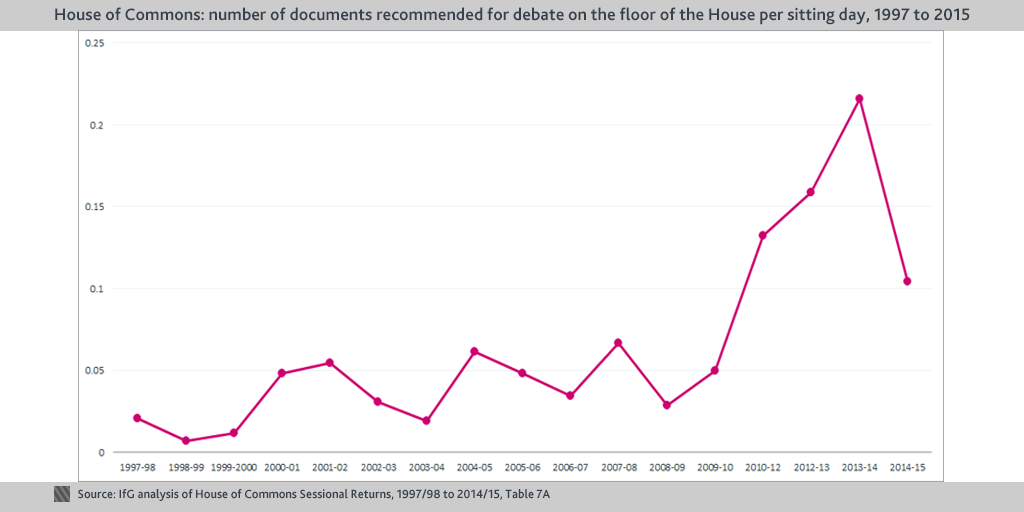
…but referral for debate is no guarantee that a debate will take place
While the committees of the two Houses can recommend documents for debate, they cannot guarantee that the debate takes place: it is up to Government whips to find time for a debate on the Floor of the House, or arrange for a temporary European Committee to hold a debate. In some sessions more debates are held than have been requested, because requests for debates are carried over between parliamentary sessions.
From 1997 to 2010, the number of floor debates requested largely matched the number of debates held. Only in sessions 2000/01, 2001/02, and 2007/08 were a number of requests turned down. However, the gap between debates requested and debates held has widened – in three of the last four sessions, the Government did not grant all of the debates requested.
5. Sometimes the Government will vote on a proposal without scrutiny having been completed
The CESC and LEC may decide to waive the scrutiny reserve, if a decision in the Council is imminent but a document has not been fully scrutinised. This may happen due to time constraints (because of a parliamentary recess, or another reason there is no opportunity for the Committee to meet in time); or because a proposal is trivial or routine.
Ministers may also unilaterally decide to override the scrutiny reserve, most often when the Council of Ministers is forced to act quickly in response to events affecting international relations or security. This explains why the FCO has consistently been the department with the highest number of overrides. Whenever ministers override the scrutiny reserve, they must write to the Committee to explain their reasons.
There is already a system in place to enable the UK parliament to influence EU legislative proposals via influence on the UK Government. But – as we have shown – this system has a number of characteristics that make it difficult for parliamentarians to engage with it. First, it involves the scrutiny of a huge number of complex and technical documents. Second, it is tightly controlled by the Government – which exercises power over the information that committees receive and which debates should take place and can, in the end, choose to override the scrutiny system at will.
If the Prime Minister is successful in his quest to give national parliaments a greater say, he will also need to think carefully about the UK Parliament’s systems for scrutinising Europe. This is essential to ensuring the UK Parliament’s voice is both representative and useful.
Abbreviations for government departments can be found here.
